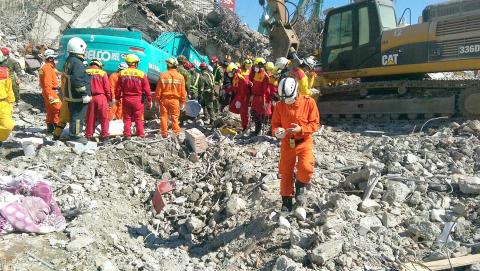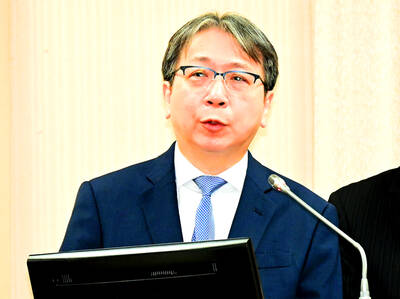Tainan Mayor William Lai (賴清德) at 4:20pm yesterday announced that the search-and-rescue operation at the Weiguan Jinlong complex in Tainan, which collapsed in an earthquake on Feb. 6, has come to an end, after the body of the last missing resident was found.
According to Central Emergency Operations Center statistics, the death toll from the magnitude 6.4 earthquake yesterday rose to a total of 116, of which 114 occurred at the Weiguan Jinlong complex, with one person who lived near the complex still missing.
The last body, which was recovered at 3:57pm yesterday, was the building’s management committee chairman, Hsieh Chen-Yu (謝鎮宇), who lived in building G, Lai said.

Photo: Hung Mei-hsiu, Taipei Times
Tainan Deputy Mayor Tseng Hsu-cheng (曾旭正) said the only person still missing after the earthquake is a woman surnamed Lin (林), who lived near the Weiguan Jinlong complex and had a habit of going out to exercise early every morning. Lin’s family has been unable to contact her since the earthquake.
The use of heavy equipment to break up and clear away rubble from the site was authorized in the hope of rescuing everyone as soon as possible, Lai said, adding that experience gained from the recovery work could be used as a reference by the National Fire Administration when considering rescue procedures in the future.
If rescue workers can use heavy equipment to retrieve bodies intact from the rubble, it means that such equipment could also be used to accelerate the search for survivors in sections that search-and-rescue personnel would not be able to reach by themselves, he said.
Even though heavy equipment was ready for use 36 hours after the earthquake, authorities were required to follow regulations and could only allow their use 62 hours after the event, which created a dilemma, Lai said.
The Construction and Planning Administration said it would expand a two-year-old-building examination project, increasing the number of buildings that are to receive subsidies of NT$8,000 for surveys and improvements this year from 500 to 2,000.
Priority is to be given to buildings in the six special municipalities and southern counties, with an emphasis to be placed on ensuring the structural safety of buildings, the administration said, adding that applications for the subsidy might begin as soon as next month.
The project, which is to examine the ability of private buildings to resist earthquakes and provide a subsidy for improvement measures, was planned in July last year, administration Director Hsu Wen-lung (許文龍) said, adding that because of the earthquake, the agency has decided to expand its scale to 2,000 buildings.
Preliminary evaluations are to include checking for cracks on buildings’ beams and pillars and peeling on exterior walls, Hsu said.
Due to southern residents’ concerns about the structural safety of buildings they live in after the earthquake, the administration is to subsidize buildings in southern Taiwan first, he added.

TRAGEDY STRIKES TAIPEI: The suspect died after falling off a building after he threw smoke grenades into Taipei Main Station and went on a killing spree in Zhongshan A 27-year-old suspect allegedly threw smoke grenades in Taipei Main Station and then proceeded to Zhongshan MRT Station in a random killing spree that resulted in the death of the suspect and two other civilians, and seven injured, including one in critical condition, as of press time last night. The suspect, identified as a man surnamed Chang Wen (張文), allegedly began the attack at Taipei Main Station, the Taipei Fire Department said, adding that it received a report at 5:24pm that smoke grenades had been thrown in the station. One man in his 50s was rushed to hospital after a cardiac arrest

PUBLIC SAFETY: The premier said that security would be tightened in transport hubs, while President Lai commended the public for their bravery The government is to deploy more police, including rapid response units, in crowded public areas to ensure a swift response to any threats, President William Lai (賴清德) said yesterday after a knife attack killed three people and injured 11 in Taipei the previous day. Lai made the remarks following a briefing by the National Police Agency on the progress of the investigation, saying that the attack underscored the importance of cooperation in public security between the central and local governments. The attack unfolded in the early evening on Friday around Taipei Main Station’s M7 exit and later near the Taipei MRT’s Zhongshan

SAFETY FIRST: Double the number of police were deployed at the Taipei Marathon, while other cities released plans to bolster public event safety Authorities across Taiwan have stepped up security measures ahead of Christmas and New Year events, following a knife and smoke bomb attack in Taipei on Friday that left four people dead and 11 injured. In a bid to prevent potential copycat incidents, police deployments have been expanded for large gatherings, transport hubs, and other crowded public spaces, according to official statements from police and city authorities. Taipei Mayor Chiang Wan-an (蔣萬安) said the city has “comprehensively raised security readiness” in crowded areas, increased police deployments with armed officers, and intensified patrols during weekends and nighttime hours. For large-scale events, security checkpoints and explosives

ON ALERT: Taiwan’s partners would issue warnings if China attempted to use Interpol to target Taiwanese, and the global body has mechanisms to prevent it, an official said China has stationed two to four people specializing in Taiwan affairs at its embassies in several democratic countries to monitor and harass Taiwanese, actions that the host nations would not tolerate, National Security Bureau (NSB) Director-General Tsai Ming-yen (蔡明彥) said yesterday. Tsai made the comments at a meeting of the legislature’s Foreign Affairs and National Defense Committee, which asked him and Minister of National Defense Wellington Koo (顧立雄) to report on potential conflicts in the Taiwan Strait and military preparedness. Democratic Progressive Party (DPP) Legislator Michelle Lin (林楚茵) expressed concern that Beijing has posted personnel from China’s Taiwan Affairs Office to its